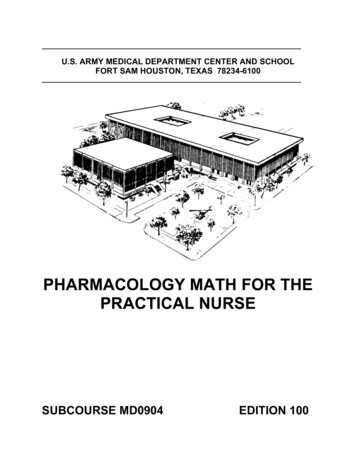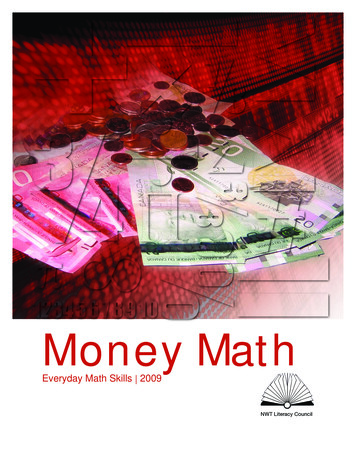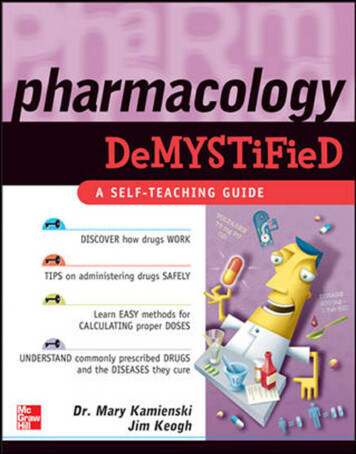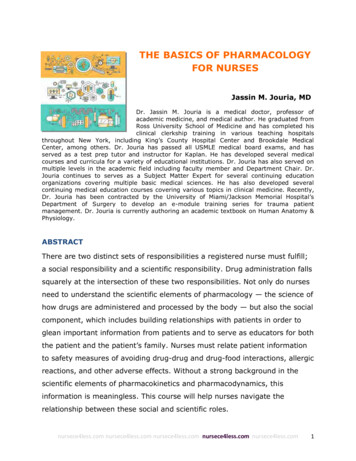
Transcription
U.S. ARMY MEDICAL DEPARTMENT CENTER AND SCHOOLFORT SAM HOUSTON, TEXAS 78234-6100PHARMACOLOGY MATH FOR THEPRACTICAL NURSESUBCOURSE MD0904EDITION 100
DEVELOPMENTThis subcourse is approved for resident and correspondence course instruction. Itreflects the current thought of the Academy of Health Sciences and conforms to printedDepartment of the Army doctrine as closely as currently possible. Development andprogress render such doctrine continuously subject to change.ADMINISTRATIONFor comments or questions regarding enrollment, student records, or shipments,contact the Nonresident Instruction Section at DSN 471-5877, commercial (210) 2215877, toll-free 1-800-344-2380; fax: 210-221-4012 or DSN 471-4012, e-mailaccp@amedd.army.mil, or write to:COMMANDERAMEDDC&SATTN MCCS HSN2105 11TH STREET SUITE 4192FORT SAM HOUSTON TX 78234-5064Approved students whose enrollments remain in good standing may apply to theNonresident Instruction Section for subsequent courses by telephone, letter, or e-mail.Be sure your social security number is on all correspondence sent to the Academy ofHealth Sciences.CLARIFICATION OF TRAINING LITERATURE TERMINOLOGYWhen used in this publication, words such as "he," "him," "his," and "men" are intendedto include both the masculine and feminine genders, unless specifically stated otherwiseor when obvious in context.
TABLE OF CONTENTSLessonParagraphsINTRODUCTION.PRETEST FOR LESSON 1Pretest Answer Sheet12BASIC MATHSection I.Basic ArithmeticSection II. FractionsSection III. DecimalsSection IV. PercentagesSection V. Ratio and 39--1-451-46--1-57PHARMACOLOGYSection I.Ratio and Proportion OperationsSection II. Systems of MeasurementSection III. Computing Medication DosagesSection IV. Computing Intravenous Infusion RatesSection V. Basic Dose -22--2-302-31--2-36MD0172i
SUBCOURSE MD0904Pharmacology Math for the Practical NurseINTRODUCTIONOne of the 91WM6's most important responsibilities is the safe administration ofmedication. Used intelligently and accurately, drugs can surely save countless numbersof lives; used unwisely, they can have disastrous results. It is imperative that you havea thorough understanding of the basic concepts of math as well as the specificmathematical skills required for pharmaceutical calculations.Subcourse Components:This subcourse consists of two lessons and a pretest. The lessons and pretest are:Lesson 1 Pretest.Lesson 1, Basic Math.Lesson 2, Pharmacology.Credit Awarded:To receive credit hours, you must be officially enrolled and complete anexamination furnished by the Nonresident Instruction Section at Fort Sam Houston,Texas. Upon successful completion of the examination for this subcourse, you will beawarded 12 credit hours.You can enroll by going to the web site http://atrrs.army.mil and enrolling under"Self Development" (School Code 555).A listing of correspondence courses and subcourses available through theNonresident Instruction Section is found in Chapter 4 of DA Pamphlet 350-59, ArmyCorrespondence Course Program Catalog. The DA PAM is available at the followingwebsite: 172ii
PRETEST FOR LESSON 1I.COMMENTS:This pretest is designed to help you identify the topics (if any)you need to review/study before going on to Lesson 2 of thissubcourse.You alone will know how you performed on the pretest. Yourpretest results will not affect your score on the final examinationfor the subcourse.Do your best. How well you perform on the pretest willdetermine how much of Lesson 1 you will need to study/reviewbefore you go on to Lesson 2.II.INSTRUCTIONS: Please read and follow these instructions as closely aspossible. The pay-off to you will be the wise use of your time.STEP 1: Carefully read the instructions for the pretest.STEP 2: Complete the 50-item pretest. Carefully read eachitem and write your answer in the space provided.Take as long as you need to complete the pretest.STEP 3: Review your work. Be sure you wrote the correctanswers.STEP 4: Check your responses against the solutions followingthe pretest. Mark each of your responses as corrector incorrect.STEP 5: Determine the number of items missed.If you did not miss any items, you may skip Lesson 1and proceed to Lesson 2.If you missed only one or two items, read theparagraph(s) referenced to the right of the solutionfor each missed question to see why your answerwas not correct. You may then proceed to Lesson 2.MD0904P-1
If you missed more than two items, you should completeLesson 1 before beginning Lesson 2.NOTE:You may complete Lesson 1 even if you are notrequired to do so.Continue with ExercisesMD0904P-2
PRETESTNOTESThroughout this subcourse, division may be indicated by " : " or by " / " or by the phrase"divided by." For example "8 divided by 4" may be shown as " 8 : 4" or "8/4.""Divided into" may be represented by ). NOTE: 4 divided into 8 ( 4 ) 8) isthe same as 8 divided by 4 (8 4).Fractions may be shown in linear (3/7) or vertical ( 3 ) form.7Mixed numbers (whole number plus a fraction) may be shown in linear or vertical form.7 . Both mean three and seven-eights.8For example, 3 7/8 and 31.19 85.956-9279. 1752. 236 276. 48x33. 4391 30197. 85x 35: 7 10. 2385 :25 11. Divide:7 : 184 12. Divide: 6 : 1 313. Multiply: 5 x623 14. Multiply: 8 x 2 315. Multiply: 211 2 x 5 316. Divide: 61 : 1 1 23MD0904P-34. 100- 238. 9873 : 9
17. Change to a mixed number6518. Change to a whole number28719. Change to lowest terms4820. Change to an improper fraction 2 4521. Explain (put into words) 1.02NOTE: In answering items 22 through 30, round off to the 2nd decimal point.22. Solve: 2.5 : 2 23. Solve: 3.45 : 10 24. Solve: 15 : 1.3 25. Solve: 66 : 2.5 26. Solve: 5.75 : 0.25 27. Solve: 7.125 x 1.3 28. Solve: 6.01 x 7 29. Convert to decimals: 1 6330. Convert to decimals:5 31. Change 50% to a fraction.32. Change 3MD09041% to a fraction.2P-4
33. Change1 % to a fraction.534. Change1 to a percent.835. Change1 to a percent.2536. Change 5% to a decimal.37. Change 2% to a decimal.38. Change 3 % to a decimal.439. Change 0.1 to a percent.40. Change 0.05 to a percent.41. Write 1 as a ratio.442. Write 1:3 as a percent.As a decimal.43. Write 1:150 as a percent.As a decimal.44. Change 10% to a ratio.45. Change 1% to a ratio.46. Change 80% to a ratio.47. Change 0.2 to a ratio.48. Change 0.025 to a ratio.49. Solve for x: 13:91 x:14MD0904P-5
50. Solve for z:z 21512Check Your Answers on Next PageMD0904P-6
PRETEST ANSWERSFollowing are the answers to the pretest you have just taken. Carefully check yourpretest.Basic Arithmetic1. 27 (para 1-2)2. 56 (para 1-2)3. 7410 (para 1-2)4. 77 (para 1-3)5. 29 (para 1-3)6. 144 (para 1-6)7. 2975 (para 1-10)8. 1097 (para 1-7)9. 25 (para 1-7)10. 95.4 or 95 2/5 (para 1-11)Fractions11. 3 12(paras 1-26, 1-18)12. 18 (paras 1-26, 1-18)13. 5914. 515. 13MD0904(paras 1-23, 1-18)(paras 1-24, 1-18)1313(paras 1-25, 1-21, 1-18)P-7
16.4 7 (paras 1-26, 1-21, 1-18)817.1 1518.4 (para 1-18)19.1 (para 1-17)220.14 (para 1-21)5(para 1-18)Decimals21. One and two hundredths (para 1-29)22. 1.25 (para 1-31)23. 0.345 0.35 (para 1-31)24. 11.538 11.54 (para 1-31)25. 26.4 (para 1-31)26. 23 (para 1-31)27. 9.2625 9.26 (para 1-34)28. 42.07 (para 1-34)29. 0.166 0.17 (para 1-36)30. 0.6 (para 1-36)Precentages31.50100MD0904 12(para 1-40)P-8
32.7200(para 1-40)33.1500(para 1-40)34. 12 12percent or 12.5 percent (para 1-41)35. 4 percent (para 1-41)36. 0.05 (para 1-42)37. 0.02 (para 1-42)38. 0.0075 (para 1-42)39. 10% (para 1-43)40. 5% (para 1-43)Ration and Proportion41. 1:4 (para 1-46)42. 33 1 percent ; 0.33 (para 1-47)343.2 % ; 0.0067 (para 1-47)344. 1:10 (para 1-50)45. 1:100 (para 1-50)46. 4:5 (para 1-50)47. 1:5 (para 1-51)MD0904P-9
48. 1:40 (para 1-51)49. x 2 (para 1-55)50. z 8.75 (para 1-55)End of Lesson 1 PretestMD0904P-10
LESSON ASSIGNMENTLESSON 1Basic Math.TEXT ASSIGNMENTParagraphs 1-1 through 1-57.LESSON OBJECTIVESAfter completing this lesson, you should be able to:SUGGESTIONMD09041-1.Add, subtract, multiply, and divide wholenumbers.1-2.Reduce fractions to lowest terms.1-3.Change improper fractions to mixed numbers orwhole numbers and mixed numbers to improperfractions.1-4.Add, subtract, multiply, and divide fractions andmixed numbers.1-5.Add, subtract, divide, and multiply decimals.1-6.Change decimals to fractions and fractions todecimals.1-7.Solve problems using the ratio and proportionmethod.After completing the assignment, complete theexercises at the end of this lesson. These exerciseswill help you to achieve the lesson objectives.1-1
LESSON 1BASIC MATHSection I. Basic Arithmetic1-1.GENERALa. Whole Numbers. The number zero and the counting numbers (0, 1, 2, 3, 4,5, 6, 7, 8, 9, 10, 11, 12, 13, 14, .) are whole numbers. The first 10 whole numbers (0through 9) are called digits.b. Powers of Ten. Our number system is based upon the powers of ten. Thatis, the digit place to the immediate left of a given digit is worth ten times as much as thegiven digit place, and the digit place to the immediate right is worth one-tenth as much.For example, in the number 321, the one tells you how many ones (or units) are in thenumber, the two tells how many tens, and the three tells how many hundreds. Seefigure 1-1.Figure 1-1. The number system.1-2.SIMPLE ADDITIONa. The numbers to be added are the addends. The answer to an additionproblem is the sum. When you are doing a problem in addition, work from right to left.Be sure to keep the columns of numbers in straight lines.b. When you "carry" a number over to the next column to the left, you can jot itdown at the top of the column.MD09041-2
EXAMPLE: Find the sum of 263, 19, and 1202.126319 120214841-3.(the 1 is "carried")(addend)(addend)(addend)(sum)SIMPLE SUBTRACTIONa. The number "from which" another number is taken away is the "minuend."The number that is taken away is the "subtrahend." The answer is the "difference."EXAMPLE: Subtract 4 from 17.17 (minuend)-4 (subtrahend)13 (difference)b. When you are doing a problem in subtraction, always remember to keep thecolumns of numbers in straight lines.c. If the minuend in any column is smaller than the subtrahend, you can"borrow" from the next column to the left. This gives you ten more to work with in theright hand column but one less in the left hand column from which you have borrowed.EXAMPLE: What is 35 minus 28?35-28To do the problem above, you have to change the 5 in the minuend to 15, andsubtract 1 from 3 in the minuend.2 1(10 is "borrowed")3/ 5-2 871-4.PRACTICE 1-1DIRECTIONS:MD0904Complete the following problems. The answers are in paragraph 1-5on the following page. If you miss two or more problems, review thesection again before proceeding with the subcourse. Follow the sameinstructions for the other practice exercises in the lesson.1-3
a. Find the sum of 29 and 13.b. Add 8 and 49.c.109 309 d. Add 13, 318, and 5.e. What is the sum of 1713 and 1694?f.Subtract 19 from 73.g. 83 - 47 h. Subtract 233 from 2011.1-5.i.From 220, subtract 59.j.What is 100 - 39?ANSWERS TO PRACTICE 1-1a.129 1342b.18 4957c.d.1109 309418113318 533611e. 171316943407MD09041-4
f.g.1-6.6173-19547183-47361 9 10 1h.2011-2331778i.220- 59161j.100-39611 11 10 9 1SIMPLE MULTIPLICATIONA number being multiplied is a "factor." The answer to a multiplication problem isa "product." When you multiply, a good habit is to keep the numbers in straightcolumns. This will help you in long multiplication problems.EXAMPLE: Multiply 36 by 6.36 factorx 6 factorTo work the problem above, follow these steps:a. Multiply: 6 x 6 36. Write down the 6 and "carry" the 3.336x66MD09041-5
b. Multiply: 3 x 6 18. Add 3 (the number carried) to 18. 3 18 21.36x62161-7.SIMPLE DIVISIONa. The number "being divided" is the dividend. The number you are "dividingby" is the divisor. The answer is the quotient.EXAMPLE:2 (quotient)(divisor) 6)12 (dividend)b. Anything left over is the remainder.EXAMPLE:26)13121 (remainder)c. The remainder can always be written as a fraction. The remainder becomesthe numerator and the divisor becomes the denominator. Thus, the remainder in theproblem above is 1/6. The quotient is 2 1/6.1-8.PRACTICE 1-2a. What is 53 times 3?b. Multiply 1139 x 2.c.209 x 6 d. What is the product of 27 and 8?e. What is 120 x 7?f.Divide 64 by 8.g. What is the quotient when 315 is divided by 5?h. 3 )18MD09041-6
1-9.i.How many times does 8 go into 4248?j.4 )139ANSWERS TO PRACTICE 1-2a.53x 3159b.1139x 22278c.209x 61254d.e.f.g.MD090415527x 82161120x 784088)64640635)31530151501-7
h.63)18180i.5318)42484024240880j.34 3/44)13912191631-10. LONG MULTIPLICATIONa. The following procedure is used for multiplying factors with two or moredigits.EXAMPLE: Multiply 35 by 25.35 factorsx 25175 subproducts700875 productSTEPS followed in the problem above:(1)Begin on the right and work left.(2)First multiply 35 by 5. 5 x 5 is 25. Write down 5 in the unit columnand carry the 2.235x255MD09041-8
(3)5 x 3 15. 15 2 17. Write down 17 to the left of the 5. The firstsubproduct is 175.35x25175(4)Next, multiply 35 by 20. Place a zero in the ones (units) column andthen multiply by 2. 2 x 5 10. Write down 0 and carry the 1.35x 2517500(5)2 x 3 is 6. 6 1 7. Write down 7 next to the 0. The secondsubproduct is 700.35x 25175700(6)Add the two subproducts. 175 700 875. This is the product.35x 25175700875b. When multiplying any factor by 10, 100, 1000 and so on, add to the factor thesame number of zeros that are in the second factor.EXAMPLE: Multiply 93 by 10. There is one zero in the 10.Therefore, add one zero to 93.93 x 10 930.MD09041-9
1-11. LONG DIVISIONThere are several techniques for doing long division. You may be used to adifferent technique from the one shown below. If you prefer another way, use it.EXAMPLE: Divide 875 by 25.3525)875751251250STEPS followed in the problem above:(1)Try to divide 25 into 87. About how many times will 25 go into 87?The answer is more than 3 but less than 4.25)875(2)Write down 3 in the space for the quotient, directly above the 7.325)875(3)Now multiply 3 x 25 and write the answer under the 87. (3 x 25 75)Write 75 under the 87.325)875751(4)Subtract 75 from 87. The difference is 12. Write 12 directly under the75.325)8757512(5)Now "bring down" the 5 from the dividend. The 12 becomes 125.325)87575125MD09041-10
(6)Divide 125 by 25. The answer is 5. Write 5 in the space for thequotient, to the right of the 3.3525)87575125(7)Multiply 5 x 25 and write the answer under the 125. (5 x 25 125)3525)875752125125(8)Subtract from 125. The difference is zero. Therefore, the quotient isexactly 35.3525)8757512512501-12. PRACTICE 1-3a. Multiply 284 by 12.b. What is the product of 310 and 219?c.Multiply 112 by 82.d. Multiply 527 by 277.e. 331 x 105 f.Divide 612 by 12.g. Divide 3928 by 491.h. If 3000 is divided by 75, what is the quotient?i.MD0904If 360 is divided by 25, what is the quotient?1-11
j.Divide 1425 by 15.1-13. ANSWERS TO PRACTICE 1-31a.284x112156812843408b.310x 219279031062067890c.112x 8222418969184d.527x 277368936891054145979e.331x 1051655331034755g.8491)3928392807i.2MD0904f.14.4 or14225)360.0 25)360252511011010010010010100010 14 35757501-12
Section II. FRACTIONS1-14. DEFINITIONA fraction is less than a whole amount. A whole number may be divided into oneor more equal parts. It is expressed by two numbers separated by a line.EXAMPLES: 1 1 2 4 52, 3, 3, 5, 6.1-15. PARTS OF FRACTIONSThe parts of a fraction are the numerator, or upper number, and the denominator,or bottom number.EXAMPLE: In the fraction 1 the "1" is the numerator, and3,the "3" is the denominator.1-16. KINDS OF FRACTIONSa. A proper fraction has a numerator that is smaller than the denominator.EXAMPLES: The fraction 1 is a proper fraction because the4numerator, “1” is smaller than the denominator. “4.”Other examples are: 1 3 and 72, 4,8.b. An improper fraction has a numerator that is larger than the denominator orequal to the denominator.EXAMPLES: The fraction 4 is an improper fraction because3the numerator “4” is larger than the denominator “3.”Other examples are 9 5 and 32, 3,3.c.A mixed number is made up of a whole number and a fraction.EXAMPLES: 2 3 is a mixed number because it has a whole4number “2” and a fraction “3/4”.Other examples are: 3 1 , 1 1, and 4 1/8.4 3MD09041-13
1-17. CHANGING FRACTIONS TO LOWEST POSSIBLE TERMSSome fractions can (and should) be changed (reduced) to their lowest terms.This is done by dividing the numerator and denominator by the same number. Thisshould be the largest possible number that will go into the numerator and denominator.A fraction is said to be at its lowest terms when the numerator and denominator cannotbe divided by the same number to arrive at a lower numerator and denominator.EXAMPLE: Reduce the fraction 912.What number goes into 9 and 12 evenly?The answer is 3.Divide the numerator by 3. 9 divided by 3 3.9 312Divide the denominator by 3. 12 divided by 3 4.9 312 4Therefore, 9 can be reduced to 3124.These two fractions are equal in value.Remember, reducing does not change the value of a fraction.1-18. CHANGING IMPROPER FRACTIONS TO MIXED NUMBERS OR WHOLENUMBERSImproper fractions are changed to mixed or whole numbers by dividing thenumerator by the denominator.EXAMPLES: 8 8 : 4 2 (a whole number)46 6 : 5 1 1 (a mixed number)551-19. PRACTICE 1-4a. Identify the following as proper fractions, improper fractions, or mixednumbers:MD09041-14
(1) 7 15(2) 13(3) 100150(4) 3010(5) 119200(6) 6 15b. Change these proper fractions to their lowest terms:(1) 28 (2) 25 75(3) 3 9c.(4) 832 (5) 515(6) 618 Change the following improper fractions to whole or mixed numbers:(1) 42 (4) 97(2) 305 (5) 1510 (3) 1412 (6) 96 1-20. ANSWERS TO PRACTICE 1-4a. (1) MixedMD09041-15
(2) Proper(3) Proper(4) Improper(5) Proper(6) Mixedb. (1) 2 1 (2 : 2 1)8 4 (8 : 2 4)(2) 25 1 (25 : 25 1)75 3 (75 : 25 3)(3) 3 1 (3 : 3 1)9 3 (9 : 3 3)(4) 8 132 4(8 : 8 1)(32 : 8 4)(5) 5 1 (5 : 5 1)15 3 (15 : 5 3)(6) 6 1 (6 : 6 1)18 3 (18 : 6 3)c.(1) 4 2 (4 : 2 2)2(2) 30 6 (30 : 5 6)5(3) 14 1 1 (14 : 12 1 1)1266(4) 9 1 2 (9 : 7 1 2)777(5) 15 1 1 (15 : 10 1 1)1022(6) 9 1 1 (9 : 6 1 1)622MD09041-16
1-21. CHANGING MIXED NUMBERS TO IMPROPER FRACTIONSMixed numbers may be changed to improper fractions by:a. Multiplying the whole number by the denominator of the fraction.b. To this answer, adding the numerator of the fraction.c.Placing this sum (or answer) over the denominator of the fraction.EXAMPLE: Change 4 2 to an improper fraction.3STEPS: (1) 4 (whole number) x 3 (denominator) 124 2 123(2) 12 (answer from ABOVE) 2 (numerator) 144 2 12 2 143(3) 14 is placed over denominator 143Thus 4 2 12 2 143331-22. ADDITION AND SUBTRACTION OF FRACTIONSa. When you add and subtract fractions, the denominators of these fractionsmust be the same. To make the denominators of two fractions the same, you have tofind the smallest denominator into which each of the original denominators will divideevenly. This is the lowest common denominator.EXAMPLE: You are given the fractions 1 and 1 and are25asked to find the lowest common denominator.What is the smallest number into which 2 and 5will divide evenly?The answer is 10. 10 is the lowest commondenominator.MD09041-17
You must now change your fractions to tenths.1 1x5 52 2x5 101 1x2 25 5x2 10REMEMBER: The new fractions are the same in value as the old fractions.b. To add fractions, find the lowest common denominator and change thefractions to fractions having the same denominator. Then add the numerators.EXAMPLE: 1 3 ?3 4Change fractions to the lowest common denominator.Then add the numerators.1 43 123 94 124 9 13 or 1 112 12 1212c. To subtract fractions, again find the lowest common denominator and changethe fractions to fractions having the same denominator. Then, subtract the secondnumerator from the first numerator.EXAMPLE: 3 - 1 ?4 339 4 121 43 129 - 4 9-4 512 12 12 121-23. MULTIPLYING TWO FRACTIONSTwo fractions may be multiplied by:a. Multiplying the numerators.MD09041-18
b. Multiplying the denominators.c.Reducing the answer to lowest possible terms.EXAMPLE: 3 x 2 3 x 2 6 3 (reduced to lowest4 5 4 x 5 20 10 possible terms).1-24. MULTIPLYING WHOLE NUMBERS AND FRACTIONSWhole numbers and fractions may be multiplied by:a. Changing the whole number to an improper fraction.b. Multiplying the two fractions.c.Reducing the answer to a mixed number in its lowest possible terms.EXAMPLE: 4 x 2 4 x 2 8 2 23 1 3 331-25. MULTIPLYING MIXED NUMBERSMixed numbers may be multiplied by:a. Changing the mixed numbers to improper fractions.b. Multiplying the two fractions.c.Reducing the answer to a mixed number in its lowest possible terms.EXAMPLE: 2 1 x 4 1 5 x 13 5 x 13 x 3 65 10 523 232661-26. DIVIDING FRACTIONSFractions may be divided by:a. Inverting the divisor (the number by which another number is divided).Inverting is done by reversing the upper number and the lower number of the fraction.b. After inverting the divisor, multiplying.MD09041-19
c.Reducing the answer to lowest terms (and/or a mixed number).EXAMPLES:3:2 3x3 9 114 3 4 2 881:1 1x5 5 123 5 3 1 334 1 : 1 9 x 3 27 13 12 3 2 1221-27. PRACTICE 1-5NOTE: Remember to reduce answers to lowest terms when possible.a. Change the following mixed numbers to improper fractions:(1)238 (2)515 (3)10 23 (4)816 (5)412 (6)2 b. Multiply the following fractions:MD0904(1)5x1 6 .3(2)9x3 10 4(3)5x1 8 2(4)7x2 8 51-20
c.(5)4x3 5 5(6)1x3 3 8Multiply the following whole numbers and fractions:(1)7x1 2(2)10 x 1 3(3)11 x 1 4(4)9x2 3(5)15 x 2 3(6)6x1 8d. Multiply the following mixed numbers:MD0904(1)33x21 52(2)9x912(3)31x21 84(4)21x31 43(5)5x414(6)82x51 34 1-21
e. Divide the following fractions and mixed numbers:(1)11:1 3 2(2)6:13(3)61:2 2(4)3:14 2(5)71:51 25(6)8:14 1-28. ANSWERS TO PRACTICE 1-5a. (1)2 3 19 (2 x 8 16 3 19)88(2)5 1 26 (5 x 5 25 1 26)55(3)10 2 32 (10 x 3 30 2 32)33(4)8 1 49 (8 x 6 48 1 49)66(5)4 1 9 (4 x 2 8 1 9)2 2(6)2 21b. (1)(2)MD09045 x 1 5 (5 x 1 5)6 3 18 (6 x 3 18)9 x 3 27 (9 x 3 27)10 4 40 (10 x 4 40)1-22
c.(3)5 x 1 5 (5 x 1 5)8 2 16 (8 x 2 16)(4)7 x 2 14 7 (7 x 2 14)8 5 40 20 (8 x 5 40)(5)4 x 3 125 5 25(6)1x3 3 13 8 24 8(1 x 3 3)(3 x 8 24)(3 : 3 1)(24 : 3 8)(1)7x1 7 312 22(7 x 1 7)(1 x 2 2)(7 : 2 3 1)2(2)10 x 1 10 3 13 33(3)11 x 1 11 2 3444(4)9 x 2 18 6 (or 9 x 2 6)331 3(5) (6)(4 x 3 12)(5 x 5 25)35115 x 2 30 10 (or 15 x 2 10)331 3136 x 1 6 3 (or 6 x 1 3)8 8 41 8 44d. (1)(14 : 2 7)(40 : 2 20)913 3 x 2 1 18 x 5 90 9 (or 18 x 5 9 9)525 2 105 2 111(2)9 x 9 1 9 x 19 171 85 12 1222(3)3 1 x 2 1 25 x 9 225 7 1848 43232(4)2 1 x 3 1 9 x 10 90 7 6 7 1 (or 9 x 10 15)43 43 12 1224 3232(5)MD09045 x 4 1 5 x 17 85 21 14 14 441-2351
(6)e. (1)137128 2 x 5 1 26 x 21 546 45 6 45 1 or 26x21 91343 4121223 4211:1 4x2 8 223 2 3 1 33(2)6 : 1 6 x 3 18 183 1 11(3)6 1 : 2 13 x 1 13 3 122 244(4)3 : 1 3 x 2 6 1 2 1 1 (or 3 x 2 3 1 1)4 2 4 1 4424 1 2212(5)7 1 : 5 1 15 x 5 75 1 23252 26 5252(6)8 : 1 8 x 4 32 324 1 11Section III. DECIMALS1-29. DEFINITIONa. The word "decimal" means ten. A decimal is a fraction whose denominator isten or a multiple of ten.b. All the numbers written to the left of the "decimal point" (a dot) are wholenumbers. The numbers written to the right of the decimal point are "decimals" (lessthan one).c. The first place to the right of the decimal point is for tenths, the second placefor hundredths, the third for thousandths, and so forth.Figure 1-2. The decimal system.MD09041-24
EXAMPLES: 0.1 one tenth0.01 one hundredth0.001 one thousandth1.0 one10.0 ten100.0 one hundred1.1 one and one tenth10.01 ten and one hundredth1-30. ADDITION AND SUBTRACTION OF DECIMALSWhen adding and subtracting decimals, remember to keep all the decimal pointsdirectly underneath each other.EXAMPLE: Add 13.102, 1.73, and .47.13.1021.73 .4715.302EXAMPLE: Subtract 4.56 from 8.2.What you will need to do is change 8.2 to 8.20. (Remember, you can alwaysadd a zero to the end of a decimal without changing its value).8.20-4.563.641-31. DIVIDING DECIMALSa. A decimal may be divided by a whole number by dividing in the usual mannerand placing the decimal point in the answer directly above the decimal point in thenumber to be divided.EXAMPLE: 5.5 : 5 1.1MD09041-25
1.15)5.55550b. A whole number may be divided by a decimal by:(1)Making the divisor a whole number by moving the decimal point to theright as many places as necessary.(2)Placing a decimal point after the whole number (dividend) and thenmoving the decimal point the same number of places to the right as the decimal point inthe divisor was moved.(3)Divide in the usual manner.EXAMPLE: 55 : 0.20.2)55 0.2.)55.0. 02)550.Thus, 55 : 0.2 275c.Now to divide a decimal by a decimal, all we do is:(1)Make the divisor a whole number.(2)Move the decimal point in the dividend the same number of places asthe decimal in the divisor was moved.(3)in the dividend.(4)Place the decimal point in the quotient directly above the decimal pointDivide in the usual manner.EXAMPLE: 5.25 : 2.5 2.5.)5.2.5 25)52.5 2.1Thus 5.25 : 2.5 2.1d. If a decimal is to be divided by a multiple of ten (10, 100, 1000, etc.), movethe decimal point as many places to the left as there are zeroes in the divisor.MD09041-26
EXAMPLE: When dividing .2 by 100, move the decimal point one placeto the left for each of the zeros in the divisor (the number youare dividing into the other number). There are two zeros;therefore, you move the decimal two places to the left.2 : 100 0.00.2 0.002EXAMPLES:(1)5 : 10 .5(2)5 : 100 .05(3)5 : 1000 .005(4) 1.8 10 .18(5) 1.8 100 .018(6) 1.8 1000 .0018e. Did you remember how to round off numbers? Whenever instructed to roundoff to a specific decimal place, solve the problem to one more place and round off.EXAMPLE: (round to 2d decimal place)52.55.2 10.096 10.101-32. PRACTICE 1-6Round the following numbers to two decimal places.a. 10.333 b. 11.625 c. 12.611d. 3.237 e. 2.621 f. 0.396Divide the following decimals; round off to second decimal place.g.100.25 50.5 h. 40.5 MD09045.5 1-27
i.82.5 0.02 j.44 2.2 k. 56 4.3 l. 43.6 5 m. 3.63 Work the following problems:n.6.2 1 00o.20 10 p. 4.3q. .08r.7 10s.12.324t.65u. .025 v. 100 1000101.34 1000w. 65.0 1000 100 100 1-33. ANSWERS TO PRACTICE 1-6a. 10.33b. 11.63c.d. 3.2412.61e. 2.62MD0904f. 0.401-28
g.1.98550.5.)100.2.50050 549 7 545 4 54 3 004 0 402 6002 52575i.41 25.0.02.)82.50.80220541010k.1 3.023 13.024.3.)56.0.000h.7.363 7.365.5.)40.5.00038 52001653 503 3020016535j.2 0.2.2.)44.0.440000l. 8.725)43.60404313 012 91001 008614012911m.MD09043635101001.23)3.6306601-29
n.062o. 2p.0043q. .0008r.07s. .12324t.065u. .0025v.00134w. .651-34. MULTIPLYING DECIMALSDecimals can be multiplied by whole numbers and decimals by:a. Multiplying in the usual manner.b. Pointing off the proper number of decimal places.5.25 x 5 26.255.25x 526.25(Two decimal places pointed off for the two places in 5.25)EXAMPLE: 5.25 x 5.5 28.8755.25x 5.52625262528.875(Three decimal places pointed off for the three places in 5.25 and 5.5)How many places would be pointed off in 3.24 x 3.56?You are correct if you answered "four."1-35. CHANGING DECIMALS TO FRACTIONSDecimals can be changed to fractions by:a. Removing the decimal point.MD09041-30
b. Placing the appropriate denominator under the number.c.Reducing to lowest terms.EXAMPLE: Change 0.05 to a fraction.05 (decimal removed)05 (note denominator) 1100201-36.CHANGING FRACTIONS TO DECIMALSFractions can be changed to decimals by dividing the numerator of the fractionby the denominator of the fraction.EXAMPLE: Change 1 to a decimal.21 : 2 (numerator : denominator).52)1.01 0.521-37. PRACTICE 1-7Multiply the following:a. 3.33 x 2.02 b. 40.1 x 4.01 c.2.55 x 20.5 d. 5.25 x 3.5 e. 7.05 x 7.5 f.85.05 x 3.05 Change the following to fractions:g. 0.35 MD09041-31
h. 0.3 i.0.04 j.0.005 k.0.75 l.0.55 Change the following to decimals:m. 1 4n. 1 6o. 7 8p. 5 7q. 2 5r.1 51-38. ANSWERS TO PRACTICE 1-7a.x3.332.0266666606.7266b.40.1x 4.01401160 40160.801MD09041-32
c. 2.55x 20.51 27551 0052.275d. 5.25x 3.52 62515 7518.375e. 7.05x 7.53 52549 3552.875f.85.05x 3.054 2525255 150259.4025g.35 7 (35 : 5 7)100 20 (100 : 5 20)h.310i.4 1k.75 3 (75 : 25 3)100 4 (100 : 25 4)l.55 11 (55 : 5 11)100 20 (100 : 5 20)m.254)1.0082020(4 : 4 1)100 25 (100 : 4 25)5 1(5 : 5 1)j.1000 200(1000 : 5 200)MD09041-33
n.166 0.176)1.0006403640364o.875 0.888)7.0006460564040p.714 0.717)5.0004910730282q.45)2.020r.25)1.010Section IV. PERCENTAGESNOTE: The final exam will not include information from Section IV. This is foryour information only.1-39. DEFINITIONPercentage means parts in 100. The term "percent" is usually indicated by thesymbol "%."1-40. CHANGING PERCENTAGES TO FRACTIONSWhen the percentage is a whole number, mixed number, or fraction, it can bechanged to a fraction by:MD09041-34
a. Omitting the percent sign.b. Writing the whole number, mixed number, or fraction as the numerator.c.Writing 100 as the denominator.d. Reducing the resulting fraction to lowest terms.EXAMPLES: Change 5% to a fraction.5% 5 1100 20Change 1% to a fraction.21100112 1 1x 1 % 212 100 2002100Change 5 1% to a fraction.25 1% 5 1 11 100 11 x 1 11222 12 100 2001001-41. CHANGING FRACTIONS TO PERCENTAGESFractions can be changed to percen
5877, toll-free 1-800-344-2380; fax: 210-221-4012 or DSN 471-4012, e-mail accp@amedd.army.mil, or write to: COMMANDER AMEDDC&S ATTN MCCS HSN 2105 11TH STREET SUITE 4192 FORT SAM HOUSTON TX 78234-5064 Approved students whose











